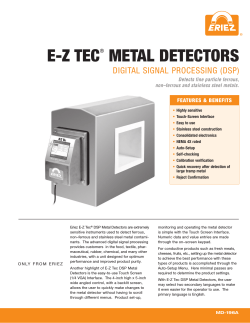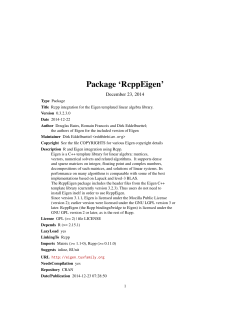
Ionospheric Situation from Huge Gas Explosion in
Disaster Advances
Vol. 7 (11) November 2014
Ionospheric Situation from Huge Gas Explosion in
Kaohsiung City in Taiwan on 31 July 2014
Jyh-Woei Lin
Dept. of Earth Science, National Cheng Kung University, No.1 University Road, Tainan City, TAIWAN
pgjwl1966@gmail.com
Abstract
This paper used two-dimensional Principal
Component Analysis (2DPCA) to determine total
electron content (TEC) respond in the ionosphere for
the huge gas explosion in Kaohsiung, Taiwan at 15:
59 (UT) on 31 July 2014. Results have shown TEC
anomaly over Kaohsiung and Taiwan from 16:00 to
16:05 (UTC) with the duration time of 5 minutes.
Potential causes of the results were discussed with
emphasis given to acoustic shock waves with the
speed of 2500m/s and caused a TEC anomaly.
Supposedly, it is possible to predict this explosion
time due to the gas release just short time before this
explosion if such explosion is very huge to reduce the
number of dead people.
y
(1)
Ax
Here x is an n dimensional project axis and y is the
projected feature of signals on x called principal component
vector.
Sx
E( y
Ey )( y
(2)
Ey ) T
Here S x is the covariance matrix of the project feature
vector.
The trace of S x is defined;
J ( x)
tr( S x )
tr( S x )
tr{x Gx } where G
T
(3)
T
E[( A EA) ( A EA)]
(4)
The matrix G is called signal covariance matrix. The
vector x maximizing eq.4 corresponds to the largest
(principal) Eigen value of G and let the largest Eigen
value be the most dominant component of the data,
therefore largest Eigen value is represented as the principal
characteristics of the data. 2DPCA can remove small
sample signal size (SSS) problem for two dimensional TEC
data. The PCA converts the measurements into onedimensional data before covariance matrix calculation. The
covariance matrix of PCA is based on an input matrix with
the dimension of m x n, which is reshaped from onedimensional data (length of m multiplying n).
Keywords: Two-Dimensional Principal Component
Analysis (2DPCA), Total Electron Content (TEC), Huge
gas Explosion, Kaohsiung, Acoustic shock waves).
Introduction
The potential area of application is in the study of
explosion related ionospheric anomalies. Blanc and
Jacobson3 described that the ionospheric anomalies were
caused through the shock wave produced by a 5-kt
chemical explosion. Andreeva et al1 used the ionosphere
radiotomography method to detect the long-lived local
disturbances of the ionospheric density over the site of
ground industrial explosions. Calais et al found Ionospheric
signature of surface mine blasts from Global Positioning
System (GPS) receivers. The perturbation starts 10 to 15
min after the blast, lasts for about 30 minutes.
Reshaping data will cause computing error because PCA is
a tool to deal with one-dimensional data. It means that the
spatial structure and information cannot be well preserved
due to some original information loss when inverting to
original dimension under the condition of the matrix being
small sample size (SSS). Such information loss is called
SSS problem. However, the covariance matrix in 2DPCA is
full rank for a matrix of low dimension. Therefore the curse
of dimensionality and SSS problem (low dimensional data
problem) can be avoided. TEC data are examined to detect
explosion-related TEC anomaly and GIMs are only used to
observe TEC situation in this study.
The goal of this paper is to use Two-Dimensional Principal
Component Analysis (2DPCA) to examine the ionospheric
spatial distribution of any driven ionospheric TEC anomaly
associated with huge gas explosion in Kaohsiung, Taiwan
at 15: 59 (UT) on 31 July 2014. The time period chosen is
from 16:00 to 16:10 on 31 July 2014. The two-dimensional
TEC data are derived. NASA Global Differential GPS
system (GDGPS) and global TEC maps (GIMs) in this
study are derived using TEC data from ~100 real-time
GDGPS tracking sites that can be available on 5 minutes
basis.6,7
TEC Image Processing: Figure 1(a) shows the GIMs
during the time from 16:00 to 16:10 on 31 July 2014. The
TEC data of the global region (not dividing the GIM for
image processing) shown in figure 1(a) are divided into 600
smaller areas 5 and 2.5 degrees in longitude and latitude
respectively. The size of each small area is 12° in longitude
and 9° in latitude.
Methods
2DPCA: For 2DPCA, let signals are represented by a
matrix A (the dimension of n x m). Linear projection of the
form is considered as follows8:
44
Disaster Advances
Vol. 7 (11) November 2014
Figure 1a: GIMs during the time from 16:00 to 16:10 (UT) on 31 July 2014.
45
Disaster Advances
Vol. 7 (11) November 2014
46
Disaster Advances
Vol. 7 (11) November 2014
\
Figure 1b: Color-coded scale of the magnitudes of principal Eigen values corresponding to fig. 1a. The color within a
grid denotes the magnitude of a principal Eigen value corresponding to fig. 1a so that there are 600 principal Eigen
values assigned respectively.
Figure 2: Kp indices from 29 July to 31 July 2014 (Space Weather Prediction Center).
47
Disaster Advances
Vol. 7 (11) November 2014
The spatial resolution of the TEC data for GDGPS system
is 5 and 2.5 degrees in longitude and latitude respectively5
and therefore 4 TEC data (two-dimensional data) are take
in each area. The 4 TEC data form a matrix A of eq.1 with
the dimensions of 2 x 2 as small sample signal size (SSS) in
each area of figure 1 (a). This allows for principal Eigen
values to be computed for each of the 600 smaller areas.
have shown that a local ranging TEC anomaly was
detectable at the time 16:00 to 16:05 UT on 31 July 2014.
The TEC anomaly could be indicative of a speed acoustic
shock wave with the speed of at least 2500m/s. The
duration time of the TEC anomaly was at least 5 minutes.
Acknowledgement
The author is grateful to NASA Global Differential GPS
system (GDGPS) for useful references Data and in memory
of deaths for this huge explosion in Kaohsiung, Taiwan.
Results
The respective results are given in figure 1(b). The
representative of large principal Eigen values in the fig.
1(b) shows the existence of explosion-related TEC anomaly
represented by a large principal Eigen value at the time
from 16:00 to 16:05 on 31 July 2014 with the duration time
of about 5 minutes. The possibility of other factors such as
solar flare and geomagnetic effects affecting the results are
considered by examining Kp indices. July, 31 was
geomagnetic quiet day shown in figure 2 (Kp<4). The
region of TEC anomaly is wide that it may be due to
ionospheric disturbances with very quick horizontal
spreading. It resulted in an Eigen value in any place of each
grid. However, for convenience to show, each grid was
filled with a uniform color. This study has shown large
Eigen value near this city.
References
1. Andreeva E.S., Gokhberg M. B., Kunitsyn V. E., Tereshchenko
E. D., Khudukon B. Z. and Shalimov S. L., Radiotomographical
Detection of Ionosphere Disturbances Caused by Ground
Explosions, Cosmic Research, January 2001, 39(1), 10-14, Doi:
10.1023/A:1002827609677 (2001)
2. Afraimovich E. L., Perevalova N. P., Plotnikov A. V. and
Uralov A. M., The shock-acoustic waves generated by
earthquakes, Annales Geophysicae, 19, 395-409 (2001)
3. Blanc E. and Jacobson A. R., Observation of ionospheric
disturbances following a 5-kt chemical explosion 2, Prolonged
anomalies and stratifications in the lower thermosphere after
shock
passage,
Radio
Sci.,
24(6),
739–746,
doi:10.1029/RS024i006p00739 (1989)
Discussion
2DPCA was able to detect Explosion-TEC anomaly found
by 2DPCA at the time 16:00 to 16:05 UT on 31 July 2014
over Kaohsiung and Taiwan and the most evident physical
mechanism was acoustic shockwave waves3 creating large
scale ionospheric density irregularities and traveling up into
the ionosphere. The duration time of TEC anomaly was
estimated at least 5 minutes. The computing process of the
shock wave speed was as follows; the time difference from
original time of the explosion to beginning time of TEC
anomaly is 60 sec and the F-lay is above 150km, then
150km÷60 sec is about 2500 m/s.
4. Calais E., Minster J. B., Hofton M. and Hedlin M., Ionospheric
signature of surface mine blasts from Global Positioning System
measurements, Geophysical Journal International, 132(1), 191202. Doi:10.1046/j.1365-246x.1998.00438.x (1998)
5. Hernández-Pajares M., Juan J. M., Sanz J., Orus R., GarciaRigo A., Feltens J., Komjathy A., Schaer S. C. and Krankowski
A., The IGS VTEC maps: a reliable source of ionospheric
information since 1998, J Geod, 83, 263–275, DOI
10.1007/s00190-008-0266-1 (2009)
6. Kechine M. O., Tiberius C.C.J.M. and van der Marel H., Realtime kinematic positioning with NASA’s Internet-based Global,
Differential GPS (IGDG). Independent performance assessment
of the GDGPS system for real-time kinematic positioning
performed at University of Delft, The Netherlands, GNSS
Conference, St. Petersburg, Russia (2004)
Afraimovich et al2 researched shock acoustic wave due to
occurring of the earthquakes to affect ionosphere. They
studied the earthquake effects in Turkey on 17 August and
12 November 1999 and in Southern Sumatra on 04 June
2000 and found the ionospheric response related to the
earthquakes due to shock acoustic wave is 180-390 s.
Compared with the result of this study, 2DPCA has shown
its advantage and credibility to estimate the duration time
of Explosion-related TEC anomaly. It is worth noting if this
explosion is very huge, then it is possible to predict this
explosion time due to much gas release just short time
before the explosion to reduce the number of dead people.
7. Ouyang G., Wang J. and Cole D., Analysis on TemporalSpatial Variations of Australian TEC, International Association of
Geodesy Symposia, 2008, 133(4), 751-758, DOI: 10.1007/978-3540-85426-5_86 (2008)
8. Sanguansat P., Principal Component Analysis– Engineering
Applications, Published by In Tech, Janeza Trdine 9, 51000
Rijeka, Croatia, 300 (2012).
(Received 01st September 2014, accepted 27th September
2014)
Conclusion
2DPCA had the advantage to detect an explosion-TEC
anomaly due to high speed acoustic shock wave. Results
48
© Copyright 2025
















